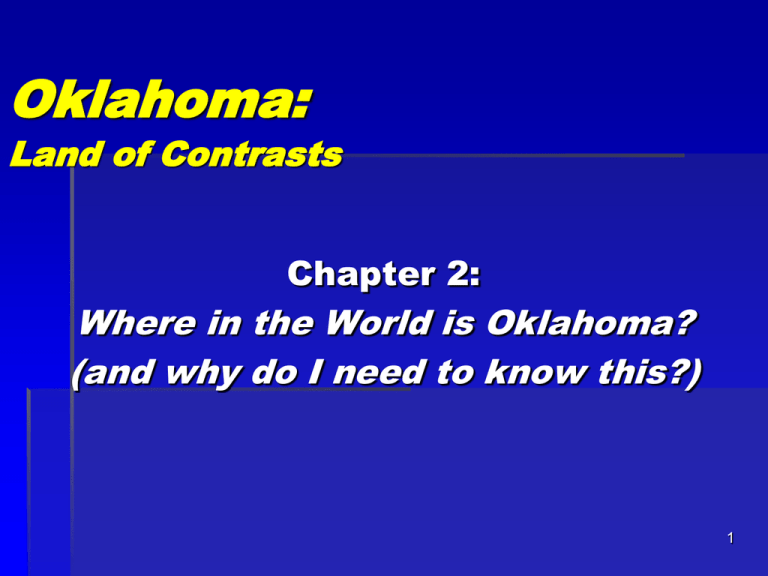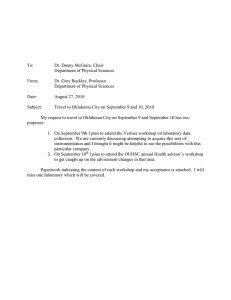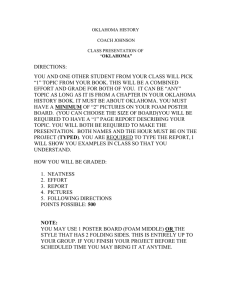Oklahoma: Land of Contrasts Where in the World is Oklahoma?
advertisement

Oklahoma: Land of Contrasts Chapter 2: Where in the World is Oklahoma? (and why do I need to know this?) 1 Section 1: What is geography? study of the physical features of the earth and how the environment affects humans. shapes the way people live, the jobs they do, the food they eat, the clothes they wear and more. Studies how people affect their surroundings. As people expanded across the land - they clear forests, dam rivers, introduce new species of insects, plants, and animals, and destroy some native plants and animals. “If you don’t like the weather…wait ten minutes, it’ll change” Will Rogers How does geographic location affect our state? Location, Location, Location!!!! Located between 94º 29' and 103º W longitude. Also lies between 33º 39' and 37º N latitude. 1829 Missouri Compromise: set the 36º 30' N latitude as the boundary where slavery could exist – included the territory that became our state Longitude = the long part of the ladder – going up Latitude – horizontal like the rungs on a ladder “laddertude” 33º 39' and 37º N latitude. 94º 29' and 103º W longitude. Oklahoma Geography Statistics Nearly 70,000 square miles (69,903 sq. miles) 1224 square miles covered by water Over 10 million acres are cover by forest Most of the state is part of a giant oval grassland that extends from Canada to Mexico. Known as the Great Plains and for many years the Great American Desert, it acts as a barrier between the species of the eastern and western forest regions. Click here to return to Main Menu. Widest east-west border: 464 miles Longest north-south border: 320 miles Ranking: 18th in size in the U.S. Larger than any state east of the Mississippi River Oklahoma: halfway between Los Angeles, California on the West Coast – Washington, D.C. to the east 77 counties Largest OSAGE COUNTY Where and What Are The Great Plains? Don’t forget the animals!!! The land is diverse – what about the climate??? Temperatures Average temperature: about 60ºF Oklahoma is often referred to as being part of the SUNBELT. Winters: short & mild Below-freezing temperatures: approx. 60 days in the south & 95 days in the north Record cold -20 degrees 1905 January: coldest month averaging 36ºF Summers: long & hot. 120 degrees in 1934 July & August: temperatures exceed 90º F Indian Summer: periods that extend high temperatures into fall & provide long growing season for agriculture – 168 days in north to 225 days along the Red River Precipitation Great variation in rainfall: influenced by its latitude and elevation Southeastern section averages 51 inches of rain per year 1957: Kiamichi Mountain Tower in the Ouachitas – recorded over 84 inches The Panhandle: about 15 inches per year Snowfall: averages only about 2 inches in the southeast & up to 30 inches in the Panhandle Hail storms, torrential rain, & lightning all cause damage Water control projects great help to flood-prone areas Line of Semi-Aridity …and Natural Resources Vegetation Western part of the state: grasslands of bluestem, buffalo grass 20% of the land about 10 million acres forested about 140 tree species native to the state – – – 6 million acres of commercial forest Oak & pine: most valuable timber commercially Trees: milled into fiberboard, plywood, & paper By 1956: U.S. Forest Service estimated only 15% of original hardwoods remained Forests slowly being reforested with new trees, better management, & wildlife containment Last 70 years: forest of red cedar trees emerging in western Oklahoma Cedar wood products: mulch, litter box chips, lumber, & insect repellent Mineral Resources Mineral Resources: includes fossil fuels – formed in the ground from the remains of dead plants and animals Fossil fuels include oil, natural gas, and coal Oil & Natural Gas First oil seepages spotted by Indians Used for medicinal purposes. Petroleum produced in 1882 Nellie Johnston No. 1 (1887) near Bartlesville: first major oil discovery; wildcatters streamed in the territory 1901: Red Fork field near Tulsa first well to be financially significant The Glenn Pool (1905): another early successful oil well. At one time this well produced 3% of the worlds oil. Tulsa became known as the “Oil Capital of the World” By statehood, Oklahoma producing 40 million barrels of oil a year 1920: production up to more than a billion barrels a year Oklahoma: ranks in the top six states in the nation in oil production and top three in natural gas 2004: output = 171,000 barrels a day Coal Coal dug first by hands of Indians & sold by the basket 1873: commercial coal mining began Coal deposits all in the eastern part of the state including Arkoma Basin Most mining done in surface operations; nearly 1.6 million tons of coal produced in Hartshorne and McAlester The Pioneer Coal Miner Memorial in McAlester: honor thousands who worked the mines & those who lost their lives Non-fuel Minerals Previous mining = Zinc, lead, manganese, & iron Sand & gravel – building construction & roadways Oklahoma granite called “grey gold”: Arbuckle & Wichita mountains Limestone mined in more than 30 counties; used for making cement and fertilizer Clay found in the state used for making bricks to build homes and buildings and for pottery Glass produced from silica sands from south-central Oklahoma Oklahoma 3rd in the country in helium production: a byproduct of natural gas wells Gypsum: used to make drywall and plaster for construction, cement, chalk, dental molds, surgical casts, paint filler, toothpaste, soil additives, tofu, and plaster of Paris Only state that produces Iodine Salt State’s salt resources in use for centuries Great Salt plains: contained within several counties in northwestern Oklahoma Eastern part of the state: numerous salt springs Removing the salt from the springs requires boiling the water until the water evaporates, leaving the salt Early 1815: salt already a commodity in the territory Soils One of state’s important natural resources Food, some clothing, & shelter come from plants grown in soil Soil: composed of organic matter, loose rock material, water, and air Mollisols: largest soil group of Oklahoma Port silt loam soil: named as one of Oklahoma’s state symbols Good for growing alfalfa, grains, cotton & other sown crops, range, pasture, and woodland Soil types: sand, silt, or clay 1920s: new technology produced more crops The Dust Bowl (1930s): affected the panhandle of Oklahoma U.S. Soil Conservation Service (1935) created to manage erosion and use soils wisely Climate and the Economy Winds: both damaging & appreciated Provide power for windmills to pump water & generate electricity to rural homes Possible replacement for fossil fuels Wind “farms” consist of giant wind turbines that generate electricity when the wind blows Transmission lines move electricity to the consumer Click here to return to Main Menu. Speaking of wind…… Estimated “Wind Resource” Tornadoes – Oklahoma = more than average number “Tornado Alley” Form from clashing air masses producing funnels with winds rotating counterclockwise Less than a ¼ mile wide to 2 miles wide Since 1950: average 54 yearly 1999: most active with 145 1988: only 17; lowest number for a year The National Severe Storms Laboratory is located in Norman Waterways 500+ rivers and streams (78,578 miles; 34 major reservoirs) Hundreds of lakes & ponds supply 60% of water consumed Much of water for agricultural irrigation Surface water used for municipal water supplies, mining, & recreation Click here to return to Main Menu. Lakes Manmade lakes and dams - to provide water for city, industrial, & agricultural growth and flood control; more manmade lakes than any other state in the nation Two largest lakes -Eufaula & Texoma The U.S. Army Corps of Engineers, the U.S. Bureau of Reclamation, and the Grand River Dam Authority responsible for building the lakes Streams and Rivers Western streams: tend to be wide and sandy with high gypsum & salt concentrations Eastern streams: receive more rainfall – generally deeper with rock banks and more rapid flow Northwest to southeast flow Arkansas and the Red Rivers are the largest Arkansas = 328 miles in Oklahoma (begins in the Rocky Mountains) carries 2/3 of the state’s runoff water Red River = 592 miles : forms the southern boundary of the state Illinois River – near Talequah Blue River – near Tishomingo So what exactly is there to do out in the Great Plains?? Map Exercise Using your textbook – pg 520 – Identify and color the 77 counties of Oklahoma. With a black marker or pen – outline the county you live in Write the Longitude and Latitude of Oklahoma on the corresponding lines of the map

